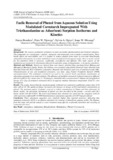| dc.description.abstract | Background: The sources of phenolics pollutants in water are mainly pharmaceutical and chemical industries. The compounds are carcinogenic, cytotoxic, mutagenic and teratogenic even at modest concentrations. These health effects are unrectifiable and it is prudent to remove phenols from water to overcome them. Despite substantial achievements on modern methods for removal of phenol from aqueous media, there is need to search for bio-adsorbent which is non-toxic, ecofriendly, cost-effective and efficient. This study reports on the modulation of cornstarch by chlorination followed by amination using triethanolamine, to be used as adsorbent.
Materials and Methods: Starch was derived from corn (maize) enriched flour purchased from Mukuyu and Maragua in Murang’a County, Kenya. All solutions were prepared using double deionized water obtained from Kenyatta University (K.U) Chemistry Laboratory. Reagents and chemicals used were of analytical grade (AR). Characterization of raw and modulated cornstarch, was done using Fourier Transform Infrared (FTIR) spectrophotometer. The modulated cornstarch was used in the removal batch experiments (optimization of adsorption parameters) on model solutions. The efficiency of modified cornstarch in phenol removal at different pH levels (pH3.0-10), contact time (5-120 minutes), initial phenolics concentration (5-40ppm) and bioadsorbent dosage (0.1-1.2g) of aminated cornstarch (ACS) in aqueous mediaat laboratory temperature (25±10C) were investigated.
Results: The results showed that the maximum uptake of phenol was realized at equilibrium contact time of 10 mins, pH of 5.0. The uptake of phenol increased with increase in dosage of ACS and initial concentration of phenol. The maximum uptake of phenol occurred at initial concentration of 10ppm and then plateaued. In kinetic models, the adsorption mechanism of phenol was best described by the pseudo – second order (K2) kinetic model with R2=0.9978. The batch experimental data obtained best fitted into the Langmuir isotherm with regression coefficientR2=0.999839and monolayer adsorption capacities of 4.2977mg/g for phenol. Conclusion: These adsorption capacities were relatively higher than reported processes, indicating that aminated cornstarch (ACS) is an effective adsorbent for removal of phenol from aqueous media. The findings from this study will provide remedy to water treatment using effective ecofriendly adsorbent and recycling of wastewater for reuse. | en_US |

